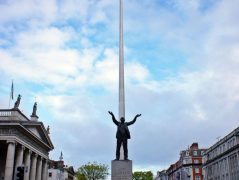
Dublin
Contents
1 Introduction2 Data and Facts3 Administration4 Economy5 Business environment6 Infrastructure7 Technology8 Social wellness and human resources9 ReferencesIntroduction
Dublin is the capital city of Ireland. It covers 115 square kilometers on the east coast of the country. The city, called Baile Atha Cliath in Irish, is situated in the Leinster province. The UN World Urbanization Prospects estimated its population for the year 2020 as 1,228,179 people. Dublin Port is the premium port of the country which adds value to its financial and commercial importance.
In 2015 the city ranked 41 among the most tourists visited cities by Euromonitor International ranks. The city is well known for its beatific landscape and exhibition of artwork. The home to the National Museum of artwork lies at the mouth of River Liffey and is flanked by a Wicklow mountain range in the south.
Data and Facts
- The population of Dublin includes more than 250,000 non-Irish nationals. And the foreign-born can be further analyzed as 23% of the non-Irish people are from the United States, 4% are from Lithuania and 13.5% people from Poland. This data was accurate for the year 2011.
- In the first quarter of 2019, 706,000 people were reported as employed. 31.7% of Ireland’s working population is settled in Dublin
- In the second quarter of 2019, the Dublin port witnessed a decline for the first time since 2013.
- The unemployment rate for the third quarter of 2019 was 4.4%. and the city ranked 5th in the FDI Fintech Location of the Future for the year 2019-2020
- Every day around 500000 people travel within the city. In the third quarter of 2019, the passenger trips in Dublin surpassed by 60 million.
- In 2018, the Financial Times positioned Dublin as Europe’s second most attractive city for foreign direct investment.
Administration
The city is the headquarters for Ireland’s government departments. Leinster House is the venue where the houses of the Irish parliament (Dail and Senate) meet. Dublin comprises of 12 constituencies, and its government is divided into two branches- legislative and executive. Where the city manager carries out the executive functions and the Dublin City Council is responsible for the legislation. The Dublin Regional Authority coordinates, reviews and monitors the functions discharged by the City Council and the three counties.
Economy
In the third quarter of 2019 the unemployment rate recorded the lowest percentage in 14 years, that is, 4.4%. Employments were generated majorly by the technology (ICT), insurance and real estate industries. In the first nine months of 2019, the Dublin airport reported 24.5 million passengers showing a growth of 5.4% from the last year. As the transportation industry prospers, public transport trips increased by 8.7% in the city. In the fourth quarter, the Dublin MARKIT PMI also recovered to 53.7 due to expansion in manufacturing. Following are the major industries contributing to the low rates of unemployment, and higher rates of economic growth-
- Information, communication and technology industry offers 9% of the total jobs in the city.
- Health and social care industries comprise 13% of the total employed people in Dublin
- Professional services represent 8.5% of the city’s employment
- Art and recreation industry report 6% of the total employment
- Logistics and storage offer 5.5% of the total employment.
The diverse and large-scale economic environment attracts foreign direct investment and numerous leading world companies to settle in Dublin. 250 global financial institutions, 50% of the world’s top 50 banks, top 5 global software companies and 18 of the world’s top 25 med-tech companies, all these reside in Dublin. In the FDI Fintech locations of the future 2019/2020, you will find Dublin in the first position due to its FDI performance, innovation, economic potential, connectivity, attractiveness, and cost-effectiveness.
Business environment
Dublin features a diverse economy with variegated business. And the business environment is known as friendly and welcoming. Dublin encourages start-ups with its low bureaucratic and low tax environment. The city also has a Dublin commissioner for start-ups. The start-ups get easy access to quality staff, suppliers experienced entrepreneurs, research institutes, investors and other development support services in the city of Dublin. The city is home to the world-class creative environment that nurtures and supports the development of innovative technology, that is named the CeADAR.
Infrastructure
In 2004 a tram system spurred functioning from the ST. Stephen’s Green in the heartland of Dublin. In 2006 the city opened the Dublin Port Tunnel connecting the port and the national motorway network. The train service running along the coast is named the DART (Dublin Area Rapid Transit). Furthermore, the city comprises of two major railway stations – the Connolly and Heuston. And the Dublin’s national airport is built in Collins town.
Technology
In 2016 the city began its Smart Dublin regional structure. This project was undertaken for the discovery of novel urban solutions with the help of an open data approach. The city aims at transforming its threats into opportunities by employing technological developments. With the effective use of technology, Dublin wants to ensure better mobility, improved energy efficiency, increased citizen participation, better response to extreme weather conditions and many more efficient services.
Some of the achievements in this field involve the real-time passenger information system for the city’s public transport, the installation of smart bins, the set of a network of sensors supervising the local weather conditions, rainfall, and river levels.
Social wellness and human resources
Dublin aims at providing a high-quality life to its residents along with nurturing nature. Health care services and education institutes are easily accessible in the city.
References
https://www.eolasmagazine.ie/dublin-smart-city/
https://www.idea.ie/dublin-smartest-city-world/
http://www.dublineconomy.ie/2018/02/01/dublin-smart-city/
https://www.easyexpat.com/en/guides/ireland/dublin/overview/economy.htm
https://www.localenterprise.ie/DublinCity/Enterprise-Development/Why-Start-a-Business-in-Dublin-/
https://dublin.ie/invest/smartdublin/
https://www.britannica.com/place/Dublin/Administration-and-society
https://worldpopulationreview.com/world-cities/dublin-population/
https://en.wikipedia.org/wiki/Dublin#Economy
https://www.worldscapitalcities.com/capital-facts-for-dublin-ireland/
https://www.dublinchamber.ie/business-agenda/economic-profile-of-dublin
https://dublin.ie/work/opportunities-in-your-industry/
https://www.irelandbeforeyoudie.com/10-fun-interesting-facts-about-dublin-you-never-knew/
 Metricsbeta
Metricsbeta
(2011 Census)